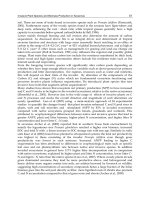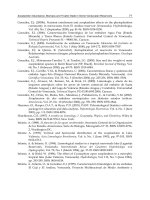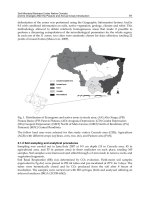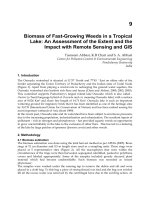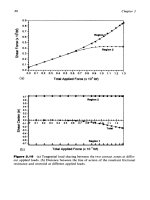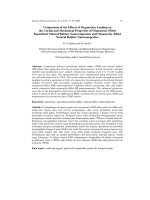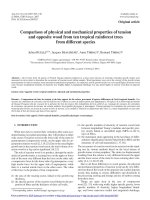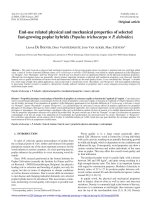Materials Science and Engineering - Electronic and Mechanical Properties of Materials Part 5 ppt
Bạn đang xem bản rút gọn của tài liệu. Xem và tải ngay bản đầy đủ của tài liệu tại đây (275.54 KB, 10 trang )
3.225
11
Density of Thermally Promoted of Carriers
∫
∞
=
c
E
dEEgEfn
)()(
Density of electron states per volume per dE
Fraction of states occupied at a particular temperature
Number of electrons per
volume in conduction
band
(
dEeEEe
m
n
Tk
E
E
g
Tk
E
e
b
g
b
F
−
∞
∫
−
=
2
1
2
3
2
*
2
2
2
1
h
π
Since
2
0
2
1
π
=
−
∞
∫
dxex
x
, then
Tk
E
Tk
E
be
b
g
b
F
ee
Tkm
n
−
=
2
3
2
*
2
2
h
π
N
C
(
(
TkEEe
e
Ef
bF
Tk
EE
Tk
EE
b
F
b
F
>>−≈
+
=
−
−
−
)(when
1
1
)(
Tk
EE
C
b
gF
eNn
−
=
(
2
1
2
3
2
*
2
2
2
1
)(
g
e
c
EE
m
Eg −
=
hπ
© E. Fitzgerald-1999
)
)
)
)
3.225
12
• A similar derivation can be done for holes, except the density of states
for holes is used
• Even though we know that n=p, we will derive a separate expression
anyway since it will be useful in deriving other expressions
Density of Thermally Promoted of Carriers
(
2
1
2
3
2
*
2
2
2
1
)( E
m
Eg
h
v
−
=
hπ
)(1where,)()(
0
EffdEEgEfp
hvh
−==
∫
∞−
Tk
E
bh
b
F
e
Tkm
p
−
=
2
3
2
*
2
2
h
π
Tk
E
v
b
F
eNp
−
=
© E. Fitzgerald-1999
)
6
3.225
13
Thermal Promotion
• Because electron-hole pairs are generated, the Fermi level is
approximately in the middle of the band gap
• The law of mass action describes the electron and hole
populations, since the total number of electron states is fixed in
the system
+==
*
*
ln
4
3
2
gives
e
h
b
g
F
m
m
Tk
E
Epn
Since m
e
* and m
h
* are close and in the ln term, the
Fermi level sits about in the center of the band gap
(
Tk
E
ve
b
i
b
g
emm
Tk
nnp
2
4
3
**
2
3
2
2
2or
−
==
h
π
© E. Fitzgerald-1999
)
3.225
14
Law of Mass Action for Carrier Promotion
(
Tk
E
he
b
i
b
g
emm
Tk
npn
−
==
2
3
**
3
2
2
2
4
h
π
Tk
E
VCi
b
g
eNNn
−
=
2
;
•
Note that re-arranging the right equation leads to an expression similar to a chemical
reaction, where E
g
is the barrier.
•
N
C
N
V
is the density of the reactants, and n and p are the products.
•
+
′
→ heNN
g
E
VC
VC
i
Tk
E
VC
NN
n
e
NN
np
b
g
2
==
−
•
Thus, a method of changing the electron or hole population without increasing the population
of the other carrier will lead to a dominant carrier type in the material.
•
Photon absorption and thermal excitation produce only pairs of carriers: intrinsic
semiconductor.
•
Increasing one carrier concentration without the other can only be achieved with impurities,
also called doping: extrinsic semiconductors.
© E. Fitzgerald-1999
)
7
3.225
15
Intrinsic Semiconductors
• Conductivity at any temperature is determined mostly by the size of the band gap
• All intrinsic semiconductors are insulating at very low temperatures
*
2
*
2
h
h
e
e
he
m
pe
m
ne
pene
ττ
µµσ =+=
Recall:
(
Tk
E
hei
b
g
een
2
int
−
∝+=
µµσ
For Si, Eg=1.1eV, and let µ
e
and µ
h
be approximately equal at 1000cm
2
/V-sec (very good Si!).
σ~10
10
cm
-3
*1.602x10
-19
*1000cm
2
/V-sec=1.6x10
-6
S/m, or a resistivity ρ of about 10
6
ohm-m max.
•
One important note: No matter how pure Si is, the material will always be a
poor insulator at room T.
•
As more analog wireless applications are brought on Si, this is a major issue
for system-on-chip applications.
This can be a
measurement
for E
g
© E. Fitzgerald-1999
+
)
3.225
16
Extrinsic Semiconductors
• Adding ‘correct’ impurities can lead to controlled domination of one carrier type
– n-type is dominated by electrons
– p-type if dominated by holes
• Adding other impurities can degrade electrical properties
Impurities with close electronic
structure to host
Impurities with very different
electronic structure to host
isoelectronic
hydrogenic
x
x
x
x
Ge
Si
P
x
x
x
x
x
x
x
x
Au
Si
deep level
E
c
E
v
E
c
E
v
E
c
E
v
E
D
E
DEEP
-
+
© E. Fitzgerald-1999
8
3.225
17
Hydrogenic Model
• For hydrogenic donors or acceptors, we can think of the electron or hole, respectively, as
an orbiting electron around a net fixed charge
• We can estimate the energy to free the carrier into the conduction band or valence band
by using a modified expression for the energy of an electron in the H atom
2222
4
6.13
8
nnh
me
E
o
n
−==
ε
2
*
22222
4*
222
4
16.131
88
2
2
εεεε
ε
m
m
nnh
em
nh
me
E
ro
e
e
o
n
r
−=→=
=
(in eV)
•
Thus, for the ground state n=1, we can see already that since ε is on the order of 10, the
binding energy of the carrier to the center is <0.1eV
•
Expect that many carriers are then thermalize at room T
•
Experiment:
•
B acceptor in Si: .046 eV
•
P donor in Si: 0.044 eV
•
As donor in Si: 0.049
© E. Fitzgerald-1999
3.225
18
The Power of Doping
• Can make the material n-type or p-type: Hydrogenic impurities are nearly fully
ionized at room temperature
–n
i
2
for Si: ~10
20
cm
-3
– Add 10
18
cm
-3
donors to Si: n~N
d
–n~10
18
cm
-3
, p~10
2
(n
i
2
/N
d
)
• Can change conductivity drastically
– 1 part in 10
7
impurity in a crystal (~10
22
cm
-3
atom density)
–10
22
*1/10
7
=10
15
dopant atoms per cm
-3
–n~10
15
, p~10
20
/10
15
~10
5
σ/σ
i
~(p+n)/2n
i
~n/2n
i
~10
5
!
Impurities at the ppm level drastically change the conductivity
(5-6 orders of magnitude)
© E. Fitzgerald-1999
9
3.225
19
Expected Temperature Behavior of Doped Material (Example:n-type)
• 3 temperature regimes
ln(n)
1/T
Intrinsic
Extrinsic
Freeze-out
E
g
/2k
b
E
b
/k
b
© E. Fitzgerald-1999
3.225
20
Contrasting Semiconductor and Metal Conductivity
• Semiconductors
– changes in n(T) can dominate over τ
– as T increases, conductivity increases
• Metals
– n fixed
– as T increases, τ decreases, and conductivity decreases
σ
τ
=
ne
m
2
© E. Fitzgerald-1999
10
3.225
21
General Interpretation of τ
• Metals and majority carriers in semiconductors
– τ is the scattering length
– Phonons (lattice vibrations), impurities, dislocations,
and grain boundaries can decrease τ
11111
++++=
gbdislimpurphonon
τττττ
1
1
=
==
iii
iithth
i
i
Nl
Nvv
l
σ
σ
τ
where σ is the cross-section of the scatterer, N is the
number of scatterers per volume, and l is the average
distance before collisions
The mechanism that will tend to dominate the scattering will be the mechanism with the
shortest l (most numerous), unless there is a large difference in the cross-sections
Example: Si transistor,
τ
phonon
dominates even though
τ
impur
gets worse with scaling.
© E. Fitzgerald-1999
3.225
22
Estimate of T dependence of conductivity
•
τ
~l for metals
•
τ
~l/v
th
for semiconductors
• First need to estimate l=1/N
σ
2
1
x
N
l
ion
ionion
ph
πσ
σ
∝
=
x=0
∫
∫
∞+
∞−
+∞
∞−
ΨΨ
ΨΨ
=
dx
dxx
x
*
2*
2
Use Ψ for harmonic oscillator, get:
1
2
−
==
kT
e
Exk
ω
ω
h
h
Average energy of harmonic oscillator
© E. Fitzgerald-1999
11
3.225
23
Estimate of T dependence of conductivity
1
1
2
−
=
=
−
==
T
kT
e
k
E
k
e
Exk
θ
ω
θ
θω
ω
h
h
h
Therefore, <x
2
> is proportional to T if T
large compared to
θ:
TNv
xNv
v
l
T
x
l
Tx
T
e
ionF
ionF
F
cond
T
π
π
τµσ
σ
θ
θ
11
111
1
2
2
2
==≈∝∝
∝∝∝
∝
+≈
For a metal:
For a semiconductor, remember that the carriers at the band edges are classical-like:
2
3
2
1
*
1
3
−
∝∝==
T
T
T
m
kT
l
v
l
th
τ
2
3
*
−
∝=
T
m
eτ
µ
© E. Fitzgerald-1999
3.225
24
Example: Electron Mobility in Ge
µ~T
-3/2
if phonon dominated
(T
-1/2
from vth, T
-1
from x-section
σ
At higher doping, the
ionized donors are the
dominate scattering
mechanism
© E. Fitzgerald-1999
12
1
3.225
1
Minority Carrier Lifetimes, τ
• Minority carriers (e.g. electrons (minority carrier) in p-type material with
majority holes
τ is the time to recombination: recombination time
– means for system to return to equilibrium after perturbation, e.g. by
illumination
E
c
E
v
τ, l
Recombination
x
E
© E. Fitzgerald-1999
Generation
• Deep levels in semiconductors act as carrier traps and/or enhanced
recombination sites
E
c
E
v
Recombination through deep level
E
deep
3.225
2
Generation and Recombination
• Generation
– photon-induced or thermally induced, G=#carriers/vol sec
– e.g. g = P/hν
–G
o
is the equilibrium generation rate
• Recombination
– R=# carriers/vol sec
–R
o
is the equilibrium recombination rate, balanced by G
o
• Net change in carrier density:
– dn/dt = G - R = G - (n - n
0
) / τ = G - ∆ n / τ
– Under steady state illumination: dn/dt = 0
–n
p
(0) = n
p0
+ G τ
Αfter turning off illumination:
–n
p
(0) = n
p0
+ G τ e
-t/τ
© H.L. Tuller, 2001
g τ
t
n
p
(t)
n
p0
n
p
(0)
τ
3.225
3
Key Processes: Drift and Diffusion
Electric Field: Drift
Concentration Gradient: Diffusion
EenJAenvI
EepJAepvI
eede
hhdh
µ
µ
==
==
;
;
neDJ
peDJ
ee
hh
∇=
∇−=
neDEenJ
peDEepJ
eeeTOT
hhhTOT
∇+=
∇−=
µ
µ
© E. Fitzgerald-1999
3.225
4
Electrochemical Potential
ϕµη
qz
jjj
+=
jjj
ckT
ln
0
+=µµ
=
ϕ
xqz
j
j
j
j
j
∂
∂
−
=
ησ
x
c
qDz
x
j
jjj
∂
∂
−
∂
∂
=
ϕ
σ
Note:
Under equilibrium conditions
0=
∂
∂
x
j
η
Electrochemical Potential ⇒E
F
Chemical Potential
Electrostatic Potential
© H.L. Tuller, 2001
2
3.225
5
Continuity Equations
• For a given volume, change in carrier concentration in time is related to J
GR
TOT
GR
TOT
GRdiffdrift
t
p
t
p
J
et
p
t
n
t
n
J
et
n
t
n
t
n
t
n
t
n
t
n
∂
∂
+
∂
∂
−⋅∇−=
∂
∂
∂
∂
+
∂
∂
−⋅∇=
∂
∂
∂
∂
+
∂
∂
−
∂
∂
+
∂
∂
=
∂
∂
1
1
1-D,
GR
x
p
D
x
E
p
t
p
GR
x
n
D
x
E
n
t
n
hh
ee
+−
∂
∂
+
∂
∂
−=
∂
∂
+−
∂
∂
+
∂
∂
=
∂
∂
2
2
2
2
µ
µ
© E. Fitzgerald-1999
3.225
6
Minority Carrier Diffusion Equations
• In many devices, carrier action outside E-field controls properties > minority
carrier devices
• Only diffusion in these regions
e
h
h
e
n
R
p
R
GR
x
p
D
t
p
GR
x
n
D
t
n
τ
τ
∆
−=
∆
−=
+−
∂
∂
=
∂
∂
+−
∂
∂
=
∂
∂
type,-pin
type,-nin
2
2
2
2
Assuming low-level injection,
t
n
t
n
t
n
t
n
o
∂
∆∂
≈
∂
∆∂
+
∂
∂
=
∂
∂
therefore
materialtype-nin
materialtype-pinG
2
2
2
2
G
p
x
p
D
t
p
n
x
n
D
t
n
h
h
e
e
+
∆
−
∂
∆∂
=
∂
∆∂
+
∆
−
∂
∆∂
=
∂
∆∂
τ
τ
© E. Fitzgerald-1999
3

